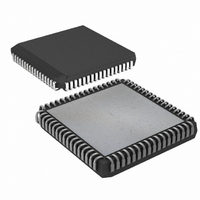DS87C550-QNL Maxim Integrated Products, DS87C550-QNL Datasheet - Page 25

DS87C550-QNL
Manufacturer Part Number
DS87C550-QNL
Description
IC MCU EPROM ADC/PWM HS 68-PLCC
Manufacturer
Maxim Integrated Products
Series
87Cr
Datasheet
1.DS87C550-QNL.pdf
(49 pages)
Specifications of DS87C550-QNL
Core Processor
8051
Core Size
8-Bit
Speed
33MHz
Connectivity
EBI/EMI, SIO, UART/USART
Peripherals
Power-Fail Reset, PWM, WDT
Number Of I /o
55
Program Memory Size
8KB (8K x 8)
Program Memory Type
OTP
Ram Size
1K x 8
Voltage - Supply (vcc/vdd)
4.5 V ~ 5.5 V
Data Converters
A/D 6x10b
Oscillator Type
External
Operating Temperature
-40°C ~ 85°C
Package / Case
68-LCC, 68-PLCC
Lead Free Status / RoHS Status
Contains lead / RoHS non-compliant
Eeprom Size
-
Available stocks
Company
Part Number
Manufacturer
Quantity
Price
Company:
Part Number:
DS87C550-QNL
Manufacturer:
Maxim Integrated
Quantity:
10 000
Part Number:
DS87C550-QNL
Manufacturer:
DALLAS
Quantity:
20 000
DS87C550 EPROM High-Speed Microcontroller with ADC and PWM
Each clock generator has an associated SFR that contains the 8-bit reload value. These registers are called
PW0FG, PW1FG, PW2FG, and PW3FG (see SFR map for addresses). In addition, there is a frequency
generator enable bit (PW0EN, PW1EN, PW2EN, & PW3EN) for each of the clock generator blocks that
must be set to a 1 before these blocks will function. These bits are set to 0 after all resets so software must
set them to 1 to enable the PWM clocks.
The output of the clock generator block is supplied to the input of the pulse generator block.
PWM PULSE GENERATOR
The pulse generator block of the PWM function produces the PWM output signal on device pins
PWMO0 (P6.0), PWMO1(P6.1), PWMO2 (P6.2), and PWMO3 (P6.3). Each of these output bits has an
enable bit: PW0OE (PW01CON.5), PW1OE (PW01CON.1), PW2OE (PW23CON.5), and PW3OE
(PW23CON.1) that are cleared to 0 on all resets, and must be set to 1 by software before the PWMs will
output a signal.
As described earlier, the pulse generator block is basically a free-running timer with a comparison
register that is loaded with an 8-bit value by software. The value of this register establishes the duty cycle
of the PWM function. The comparison values are stored in SFRs PWM0, PWM1, PWM2, and PWM3 for
the respective PWM channels, and it is these values that determine the pulse duration.
Actually, in accessing these specific SFRs, software has access to both the compare registers and the
timer registers of the pulse generator blocks. When the PWM Timer/Compare Value Select SFR bits
PW0T/C
(PW01CON.4),
PW1T/C
(PW01CON.0),
PW2T/C
(PW23CON.4),
and
PW3T/C
(PW23CON.0) are cleared to 0, a read or write to the respective PWMx register accesses the compare
register. When these bits are set to 1, a read or write accesses the timer value. With the use of these bits,
the timers in the pulse generator sections of the PWM functions can be used as general-purpose timers if
desired.
When the free-running timer of the pulse generator block rolls over from FFh to 00h, the PWM output is
set to a 1. As the timer continues to count up from 0, the output of the PWM is cleared to 0 when the
timer value is equal to the comparison register value. This cycle continues automatically without
processor intervention until software or a reset changes some condition.
The value of 0 in the comparison register is a special case of each PWM function. Rather than allow a set
and a reset of the PWM output bit, special hardware ensures that 0 will be output continuously if 0 is
loaded into the compare register.
There are other SFR bits that affect PWM operation for special modes. Bits PW0DC (PW01CON.6),
PW1DC (PW01CON.2), PW2DC (PW23CON.6), and PW3DC (PW23CON.2) cause the output of the
respective PWM function to be a constant 1. This feature may be useful for driving a fixed DC voltage
into any circuitry attached to the PWM output. Bits PW0F (PW01CON.7), PW1F (PW01CON.3), PW2F
(PW23CON.7), and PW3F (PW23CON.3) are flags that are set by the hardware when the respective
PWM pulse generator timer rolls over from FFh to 0. These flags must be cleared by software to remove
their set condition.
16-BIT MODE
For more precise PWM operations, two 8-bit PWMs may be combined into a single 16-bit PWM
function. By setting SFR bit PWE0 (PWMADR.0) to a 1, a new 16-bit PWM0 function is formed from
the 8-bit PWM functions PWM0 (LSB) and PWM1 (MSB). Similarly, by setting PWE1 (PWMADR.1) to
25 of 49














